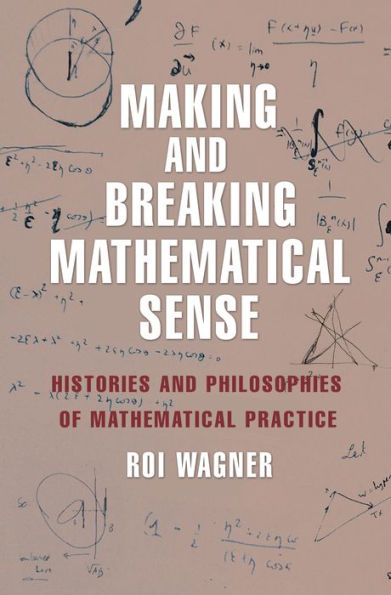
Making and Breaking Mathematical Sense: Histories and Philosophies of Mathematical Practice
256
Making and Breaking Mathematical Sense: Histories and Philosophies of Mathematical Practice
256Hardcover
-
PICK UP IN STORECheck Availability at Nearby Stores
Available within 2 business hours
Related collections and offers
Overview
Roi Wagner uniquely combines philosophical, historical, and cognitive studies to paint a fully rounded image of mathematics not as an absolute ideal but as a human endeavor that takes shape in specific social and institutional contexts. The book builds on ancient, medieval, and modern case studies to confront philosophical reconstructions and cutting-edge cognitive theories. It focuses on the contingent semiotic and interpretive dimensions of mathematical practice, rather than on mathematics' claim to universal or fundamental truths, in order to explore not only what mathematics is, but also what it could be. Along the way, Wagner challenges conventional views that mathematical signs represent fixed, ideal entities; that mathematical cognition is a rigid transfer of inferences between formal domains; and that mathematics’ exceptional consensus is due to the subject’s underlying reality.
The result is a revisionist account of mathematical philosophy that will interest mathematicians, philosophers, and historians of science alike.

Product Details
| ISBN-13: | 9780691171715 |
|---|---|
| Publisher: | Princeton University Press |
| Publication date: | 01/10/2017 |
| Pages: | 256 |
| Product dimensions: | 6.10(w) x 9.30(h) x 1.10(d) |
About the Author
Table of Contents
Acknowledgments xi
Introduction 1
What Philosophy of Mathematics Is Today 1
What Else Philosophy of Mathematics Can Be 3
A Vignette: Option Pricing and the Black-Scholes Formula 6
Outline of This Book 10
1: Histories of Philosophies of Mathematics 13
History 1: On What There Is, Which Is a Tension between Natural
Order and Conceptual Freedom 14
History 2: The Kantian Matrix, Which Grants Mathematics a
Constitutive Intermediary Epistemological Position 22
History 3: Monster Barring, Monster Taming, and Living with Mathematical Monsters 28 History 4: Authority, or Who Gets to Decide What Mathematics
Is About 33
The “Yes, Please!” Philosophy of Mathematics 37
2: The New Entities of Abbacus and
Renaissance Algebra 39
Abbacus and Renaissance Algebraists 39
The Emergence of the Sign of the Unknown 40
First Intermediary Reflection 45
The Arithmetic of Debited Values 46
Second Intermediary Reflection 51
False and Sophistic Entities 53
Final Reflection and Conclusion 56
3: A Constraints-Based Philosophy of
Mathematical Practice 59
Dismotivation 59
The Analytic A Posteriori 63
Consensus 67
Interpretation 72
Reality 81
Constraints 84
Relevance 90
Conclusion 97
4: Two Case Studies of Semiosis in Mathematics 100
Ambiguous Variables in Generating Functions 101
Between Formal Interpretations 101
Models and Applications 107
Openness to Interpretation 109
Gendered Signs in a Combinatorial Problem 112
The Problem 112
Gender Role Stereotypes and Mathematical Results 116
Mathematical Language and Its Reality 120
The Forking Paths of Mathematical Language 122
5: Mathematics and Cognition 128
The Number Sense 129
Mathematical Metaphors 137
Some Challenges to the Theory of Mathematical Metaphors 142
Best Fit for Whom? 143
What Is a Conceptual Domain? 146
In Which Direction Does the Theory Go? 150
So How Should We Think about Mathematical Metaphors? 154
An Alternative Neural Picture 156
Another Vision of Mathematical Cognition 163
From Diagrams to Haptic Vision 164
Haptic Vision in Practice 171
6: Mathematical Metaphors Gone Wild 177
What Passes between Algebra and Geometry 177
Piero della Francesca (Italy, Fifteenth Century) 178
Omar Khayyam (Central Asia, Eleventh Century) 179
René Descartes (France, Seventeenth Century) 181
Rafael Bombelli (Italy, Sixteenth Century) 183
Conclusion 187
A Garden of Infinities 188
Limits 189
Infinitesimals and Actual Infinities 194
7: Making a World, Mathematically 199
Fichte 201
Schelling 206
Hermann Cohen 209
The Unreasonable(?) Applicability of Mathematics 213
Bibliography 219
Index 233
What People are Saying About This
"Mathematicians and philosophers should find this excellent book accessible and stimulating. As a mathematician, I was pleasantly surprised that some of Deleuze's philosophy could be made not just comprehensible but compelling. Among the new mathematical material, the book's account of Bombelli and the cubic equation was particularly impressive. And the story of the emergence of negative and imaginary numbers has never been told with such subtlety and clarity."—John Stillwell, University of San Francisco"Most contemporary analytic theories give pat characterizations of the nature of mathematics. But Wagner argues that the complexity and richness of the subject resist such formulas. Accessible to philosophers and philosophically curious mathematicians, this is a fresh, interesting, and thought-provoking book."—Jeremy Avigad, Carnegie Mellon University
